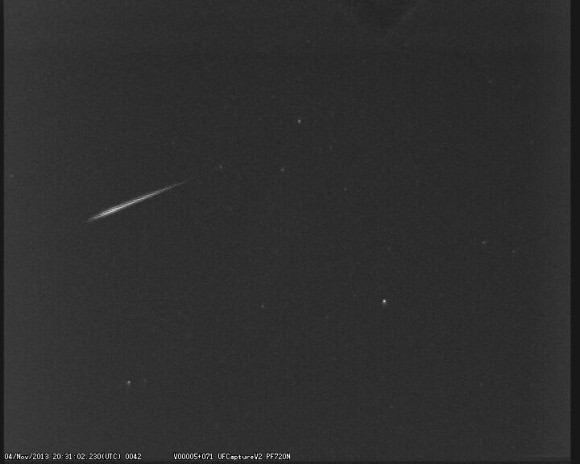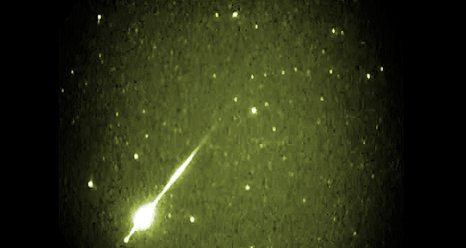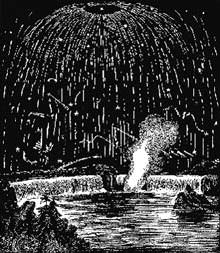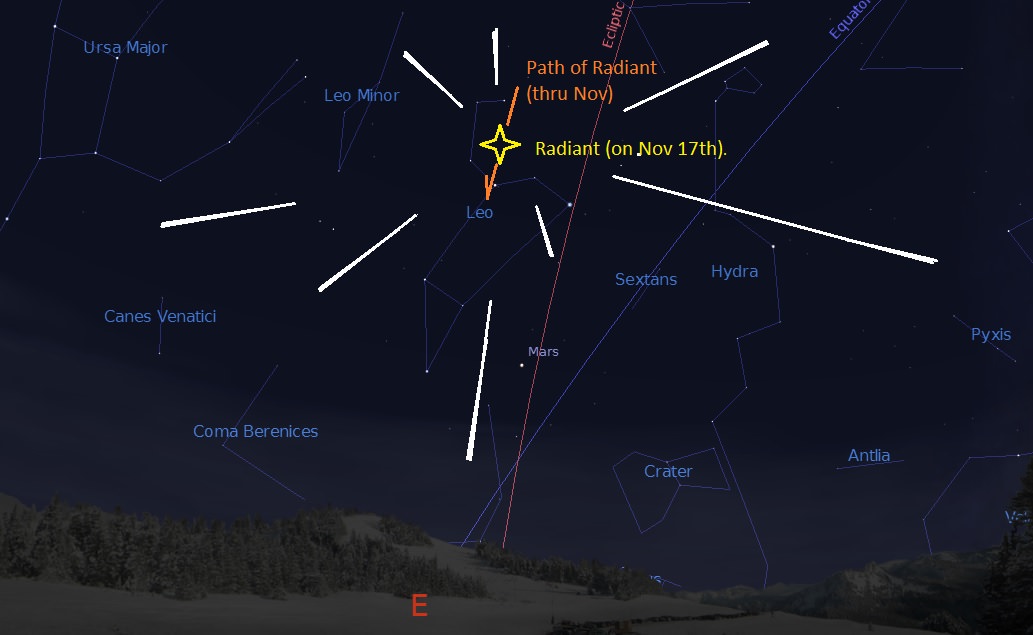November 2013 offers a chance to catch a dependable meteor shower, albeit on an off year. The Leonid meteors are set to reach their annual peak this coming weekend on Sunday, November 17th. We say it’s an off-year, but not that it should discourage you from attempting to catch the Leonids this weekend in the early dawn.
Projections for 2013 suggest a twin-peaked maximum, with the first peak arriving on November 17th at 10:00 UT/5:00 AM EST favoring North America, and the second one reaching Earth on the same date six hours later at 16:00 UT/11:00, favoring the central Pacific.
Unfortunately, the Full Moon also occurs the on very date that the Leonids peak at 10:16 AM EST/ 15:16UT, right between the two peaks! This will definitely cut down on the number of meteors you’ll see in the early AM hours.
That’s strike one against the 2013 Leonids. The next is the curious sporadic nature of this shower. Normally a minor shower with a zenithal hourly rate (ZHR) in the range of 10-20 per hour, the Leonids are prone to great storms topping a ZHR of 1,000+ every 33 years. We last experienced such an event in 1998 and 1999, and we’re now approaching the mid-point lull between storms in the 2014-2016 time frame.

Still, this is one shower that’s always worth monitoring. The source of the Leonids is Comet 55p/Tempel-Tuttle, which is on a 33-year orbit and is due to reach perihelion again in 2031.
Note that the Leonids have also continued to show enhanced activity in past years even when the Moon was a factor:
2012- ZHR=47.
2011- ZHR=22, Moon=8% waning gibbous.
2010- ZHR=40, 86% waxing gibbous.
2009- ZHR=79.
2008-70 ZHR=72% waning gibbous
We even managed to observe the Leonid meteors from Vail, Arizona in 2002 and 2005, on years when the Moon was nearly Full.
Now, for the good news. The Leonids have a characteristic r value of 2.5, meaning that they produce a higher than normal ratio of fireballs. About 50-70% of Leonid meteors are estimated to leave persistent trains, a good reason to keep a pair of binoculars handy. And hey, at least the 2013 Leonids peak on the weekend, and there’s always comet’s ISON, X1 LINEAR, 2P/Encke and R1 Lovejoy to track down to boot!

Here’s a few tips and tricks that you can use to “beat the Moon” on your Leonid quest. One is to start observing now, on the moonless mornings leading up to the 17th. You’ll always see more Leonid meteors past local midnight as the radiant rises to the northeast. This is because you’re standing on the portion of the Earth turning forward into the meteor stream. Remember, the front windshield of your car (the Earth) always collects the most bugs (meteors). Observers who witnessed the 1966 Leonid storm reported a ZHR in excess of thousands per hour, producing a Star Trek-like effect of the Earth plowing through a “snowstorm” of meteors!
The radiant of the Leonids sits in the center of the backwards question mark asterism of the “Sickle” in the astronomical constellation Leo (hence name of the shower).
You can also improve your prospects for seeing meteors by blocking the Moon behind a building or hill. Though the Leonids will appear to radiate from Leo, they can appear anywhere in the sky. Several other minor showers, such as the Taurids and the Monocerotids, are also active in November.
Meteor shower photography is simple and can be done with nothing more than a DSLR camera on a tripod. This year, you’ll probably want to keep manual exposures short due to the Full Moon and in the 20 seconds or faster range. Simply set the camera to a low f-stop/high ISO setting and a wide field of view and shoot continuously. Catching a meteor involves luck and patience, and be sure to examine the frames after a session; every meteor I’ve caught on camera went unnoticed during observation! Don’t be afraid to experiment with different combinations to get the sky conditions just right. Also, be sure to carry and extra set of charged camera batteries, as long exposures combined with chilly November mornings can drain DSLR batteries in a hurry!

The Leonids certainly have a storied history, dating back to before meteors where understood to be dust grains left by comets. The 1833 Leonids were and awesome and terrifying spectacle to those who witnessed them up and down the eastern seaboard of the U.S. In fact, the single 1833 outburst has been cited as contributing to the multiple religious fundamentalist movements that cropped up in the U.S. in the 1830s.
We witnessed the 1998 Leonids from the deserts of Kuwait while stationed at Al Jabber Air Base. It was easily one of the best meteor displays we ever saw, with a ZHR reaching in access of 500 per hour before dawn. It was intense enough that fireballs behind us would often light up the foreground like camera flashes!
Reporting rates and activity for meteor showers is always fun and easy to do — its real science that you can do using nothing more than a stopwatch and your eyes. The International Meteor Association is always looking for current meteor counts from observers. Data goes towards refining our understanding and modeling of meteor streams and future predictions. The IMO should also have a live ZHR graph for the 2013 Leonids running soon.
Have fun, stay warm, send those Leonid captures in to Universe Today, and don’t forget to tweet those meteors to #Meteorwatch!


Big moon… big sigh… Oh well, where would we be without La Selena?
Here on the left coast we experienced a Leonid meteor storm in 2001 with rates as high as 1,000 per hour.. a mind blowing experience! I’d love to see something like
THAT again!